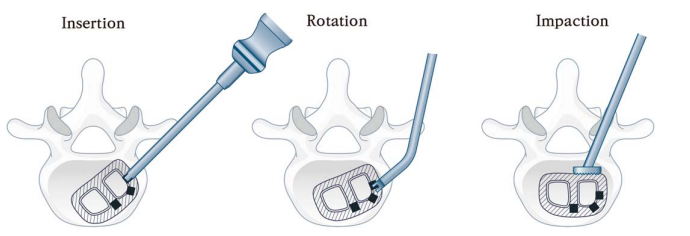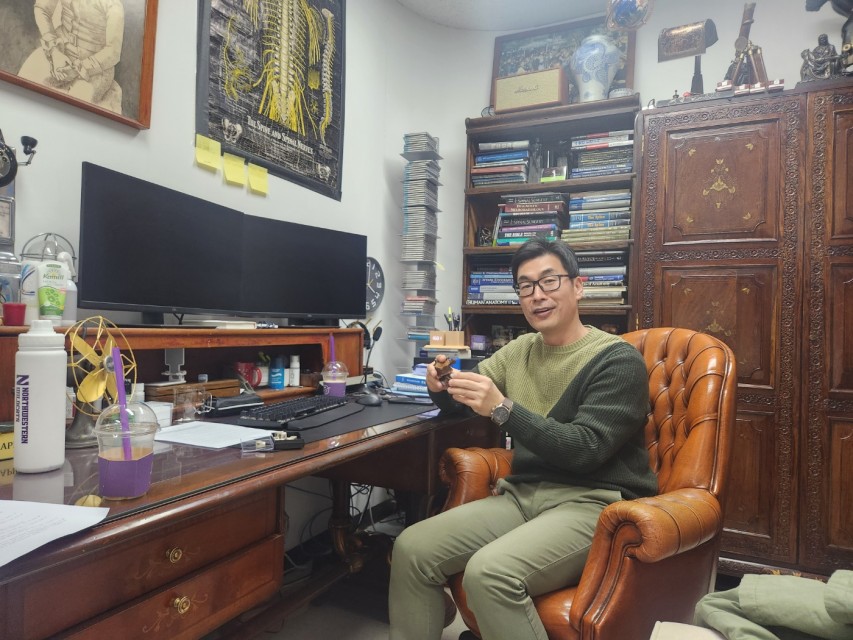[Feature] Prof. Jo Dae-jean’s Team Pioneers a Breakthrough in Spinal Surgery
A research team led by Professor Jo Dae-jean from Kyung Hee University Hospital at Gangdong (KHUHG) has achieved a breakthrough in spinal surgery. On January 6, 2025, KHUHG announced that Prof. Jo and his team had presented a new surgical technique, for the first time in the world, that integrates the benefits of both the conventional anterior and posterior approaches while over coming their limitations.
Prof. Jo Dae-jean during the interview in his office in Gangdong-gu, Seoul
A Breakthrough in Spinal Surgery
The new extratransforaminal lumbar interbody fusion (ExTLIF) technique involves a special fusion cage developed by Prof. Jo and his team, and it is notably larger than conventional anterior lumbar interbody fusion (ALIF) cages. This innovation offers hope for patients who are at high risk for anterior spinal surgeries due to conditions such as obesity, vascular anomalies, or prior abdominal surgeries.
His team’s findings, published last November in the prestigious medical journal Clinical Spine Surgery, were presented in their study titled Anterior Column Support with Anterior Lumbar Interbody Fusion Cage Through Posterior Approach Maneuver. The publication highlights the global significance of the team’s research.
Limitations of Convention al Surgeries
Patients with severe spinal disease, such as disc disorders, spondylolisthesis, spinal stenosis, spinal fractures, chronic lower back pain, or scoliosis, rarely experience significant symptom relief with conservative treatments such as medication or physical therapy. Instead, spinal surgery is often required, particularly for elderly patients whose daily lives are profoundly affected by their symptoms.
Conventional spinal surgeries include those with anterior and lateral approaches, such as ALIF, direct lumbar interbody fusion (DLIF), and oblique lumbar interbody fusion (OLIF). In contrast, posterior lumbar interbody fusion (PLIF) and transforaminal lumbar interbody fusion (TLIF) are techniques that access the spine from the back.

Illustration of how to insert the cage
Photo: Clinical Spine Surgery (clinicalspinesurgery.com)
Conventional anterior approaches provide a larger space for cage insertion, making them effective for restoring lumbar lordosis. However, they carry a higher risk of damaging vital organs such as the small intestine, large intestine, bladder, and major blood vessels like the aorta. Additionally, in young male patients, this approach can lead to retrograde ejaculation, a condition in which semen enters the bladder instead of exiting through the urethra, potentially causing infertility.
On the other hand, posterior surgeries are generally safer as they avoid entering from the front. However, they provide limited space for cage insertion, restricting the ability to restore lumbar lordosis effectively.
For patients whose conditions were not suitable for anterior surgeries, outcomes were merely satisfactory due to the limitations of PLIF and TLIF. Recognizing these challenges, Prof. Jo’s team aimed to develop a surgical method that could address the shortcomings of PLIF and TLIF while providing an alternative for patients ineligible for anterior surgeries. Since most patients with severe spine problems are elderly, Prof. Jo and his colleagues sought to develop a new approach that could be applied to a broader range of patients. They had to think of a way to solve chronic issues in spinal surgeries leading to a breakthrough.
On the Road for ExTLIF Surgery
In this study, Prof. Jo’s team developed a modified posterior approach called ExTLIF, which maintains the key advantages of ALIF, such as restoring lumbar lordosis and ensuring stable cage placement. ExTLIF also successfully reduces surgical time and minimizes complications. They used ExTLIF cages made of Polyetheretherketone (PEEK), which are suitable for molding and have an elastic modulus that closely matches that of bone. Prof. Jo noted that in the past, titanium and carbon cages were widely used. However, they either mismatched the elastic modulus or were too difficult to mold due to their monolithic structure. PEEK cages are more suitable for elderly patients with relatively weak bones.

A conventional ALIF cage
Photo: Clinical Spine Surgery (clinicalspinesurgery.com)
A major distinction of ExTLIF is its ability to insert an ALIF cage via a posterior approach, which was previously challenging without anterior access. By utilizing this posterior method, the procedure minimizes nerve damage and eliminates the need for abdominal incisions. This design significantly reduces the risk of injury to major blood vessels and organs, which are typically vulnerable in ALIF procedures. Additionally, the simplified surgical process leads to shorter operation times. To evaluate the effectiveness of this approach, Prof. Jo’s team performed the surgery on 51 patients and analyzed the outcomes. The patients were divided into two groups:
Group one: 35 patients who underwent standard spinal fusion
Group two: 16 patients with severe spinal deformities requiring correction
The average age of the patients was 69.4 years for group one and 71.4 years for group two.
The study results demonstrated that ExTLIF achieves clinical outcomes comparable to ALIF, including high fusion rates and preserved lumbar lordosis, while also facilitating faster patient recovery and lowering the risk of complications. Notably, the study analyzed subsidence rates, which refer to the sinking of the cage into the vertebral body.
Group one had a subsidence rate of 85.4%.
Group two had a lower rate of 68.8%.
Furthermore, in group one, subsidence was found to be significantly correlated with cage height, indicating that a taller cage increased the likelihood of subsidence. Logistic regression analysis revealed that for every two-millimeter increase in cage height, the risk of subsidence increased by approximately 1.8 times.
ExTLIF has broadened the range of patients eligible for surgical treatment, particularly those for whom ALIF was previously unsuitable. Through this research, Prof. Jo’s team has successfully overcome the limitations of conventional techniques, marking a significant advancement in South Korea’s medical technology.
He is now moving on to the next step while keeping one principle in mind: “Surgeons should never underestimate even the simplest procedures. In medicine, there is no room for overconfidence—only for relentless pursuit of better outcomes.”
There are no registered comments.
I agree to the collection of personal information. [view]


